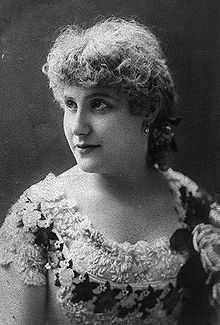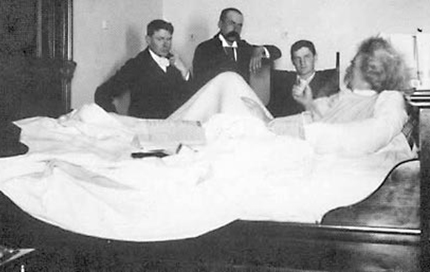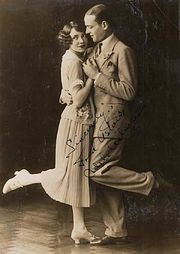Entertainment before the Orpheum
One of the earliest references we have to entertainment in the Vancouver area is in 1861 when a touring San Francisco company arrived to entertain the Royal Engineers here. The Engineers had been sent to build our earliest roads and bridges, and to discourage any thoughts of expansionism by the Americans a few miles south. One of the touring troupe, a 16-year-old girl named Lulu Sweet, a singer, became an instant favorite with the troops . . . and thereby hangs a tale. On January 10, 1861 (a date of January 12, 1860 is also cited), during a tour of local waters, the commander of the Engineers, Col. Richard Moody, was showing Miss Sweet various features of the landscape. As they passed one island in the Fraser, she asked its name. “It has no name as yet,” Col. Moody responded, “but in tribute to you we shall call it Lulu Island.” So more than 140 years ago show business made its mark on the Greater Vancouver landscape! There is a photograph of Miss Sweet here.
We don’t hear much about entertainment for the next couple of decades. It was happening; it’s just that not much made it into written history.
The Midnight Adieu Club held dances every couple of weeks at Blair’s Hall in Vancouver in the early 1880s, a location also used by the local Catholic Church for its masses. A place called Columbia Hall opened June 5, 1886 with Webster and Stehle, an acrobatic song and dance team. That was a full 25 years after Lulu Sweet and her company had passed through.
Vancouver’s first band concert occurred April, 1887 (opening with the playing of The Maple Leaf Forever, written 20 years earlier and already a sort of national anthem). Records of paid entertainment in the interim are sparse—most entertainment of the time was home-made, when family members would sing, play musical instruments and perhaps even dance for visiting friends and family. The Imperial Opera House presented visiting stock companies, minstrel shows and variety entertainments. Sometimes, even at this early stage, big names of the time would stop by. The first Shakespeare production in the city, says Sheila Roberts in her book Shakespeare in Vancouver, was on December 5, 1889 with Richard III at the Imperial Theatre. “Now is the winter of our discontent made glorious summer by this son of York . . .”

Then, on February 9, 1891 the CPR opened the $200,000 Vancouver Opera House on Granville Street near where Sears (nee Eatons) stands today. The initial show in the 1,200-seat theatre was a performance by the Emma Juch English Opera company, a touring company from the US. The CPR paid the Juch organization $10,000 to stage Wagner’s Lohengrin. In September the great Sarah Bernhardt appeared there, starring in Fedora . . . speaking entirely in French. Still, to have The Divine Sarah appear in a city of some 13,000 residents was an important occasion, and the local newspapers knew it. (On that same day, September 21, 1891, another form of entertainment was unveiled in the city when E.H. Wall demonstrated the new-fangled Edison gramophone, great-grandfather of today’s CD players.)

The VOH would become an important part of Vancouver’s entertainment scene for many years, and those who were here when it was active remember streetcars lining up to wait for the exit of the late theatre crowd . . . which played havoc with schedules and traffic.
That word “opera” in the theatre’s name—as was also the case with the Imperial Opera House—was misleading. The first production at the VOH was an opera, true, but other operas were actually few and far between on these stages. Much more frequent were variety shows. A Daily World edition of Sept. 28, 1893 carries exactly one entertainment-themed ad, and it’s for the Imperial. They were presenting The Oliver Musical Comedy Company “in a highly entertaining and amusing programme, consisting of Songs, Dances, Pleasing Specialties, Roaring Comedy Sketches, Funny Farces.” Prices were 15, 25 and 35 cents. The theatre invited the public to attend a free concert by its Novelty Band on the street each day at 2:30.

Image: Wikipedia
Mark Twain came to the Imperial August 15, 1895 and made audiences laugh so long and loud that parts of his commentary couldn’t be heard. Twain had a bad cold at the time, and a famous photograph shows him laid up at the Hotel Vancouver and chatting with writers from the local newspapers. Public speaking and poetry readings were big draws at the time. In October of 1897 Pauline Johnson was reading her poems to a big crowd at Homer Street Methodist Church. From 1895 to 1902 the Vancouver Opera House, with its 1,200 seats, was leased by Robert Jamieson. He brought in musicals, opera, vaudeville and drama . . . and also gave us his son, Teddy, who was to become one of Vancouver’s best known musicians. It was Teddy Jamieson who led the orchestra at the 1927 opening of today’s Orpheum.
Harry Lindley was a prominent theatrical figure in Canada around the turn of the 20th century, and has been called Vancouver’s first resident professional. His company performed plays in the 1890s with titles like In the Cariboo and A Scene on Hastings. Lindley and his company made annual tours of Canada, performing at various cities. One of his company’s hits was a play titled The Duplicate Man, in turn written by the Prairie playwright and journalist Kate Simpson Hayes. So there was lots of Canadian content, even more than a hundred years ago. (They spread it around, too: Lindley’s company ventured into the U.S. with some success.)
Some of these stage presentations were extraordinarily complex and vast: a touring production of Ben Hur at the VOH had a cast of 275 and a real chariot race! There were four live horses for each chariot, running on a treadmill . . . with everyone deserting the wings in case there was an accident.
On August 2, 1897 the “movies” came to Vancouver with an Edison Kinetoscope exhibition at Market Hall. (The first public demonstration of the Kinetoscope had been at the Brooklyn Institute of Arts and Sciences in New York May 9, 1893.) For some time, however, movies would not be an important entertainment factor. They were still too crude to be more than a novelty. On October 7, 1898 what may have been Canada’s first motion picture theatre opened on Cordova Street in Vancouver, but one hears nothing of it after its opening. In 1902 the Edison Electric Theatre—called Canada’s first permanent cinema—opened in Vancouver but, again, one hears little or nothing of it after its opening. Frank Kerr opened a movie house in New Westminster two years later. The first motion picture house in North Vancouver opened in Larson’s Pavilion in June of 1909. Flat (and fat) black discs of the Victor Talking Machine Company and magic lanterns began to bring a new kind of entertainment into the home.
The Province newspaper began appearing as a daily in Vancouver March 26, 1898, but advertisements for entertainment events were still sparse. Their edition of September 1, 1898 has a single “showbiz” ad, for the Vancouver Opera House, showing a Japanese musical play titled The Geisha. The show was presented “under the auspices of” the Lyric Operatic and Dramatic Association. Tickets were $1, then 75 cents, 50 cents and 25 cents.
Six years more and now there are three theatres advertising: the VOH, the Peoples Theatre at Pender and Howe, and the Empire at Hastings at Gore. The Empire noted in its advertisement January 2, 1904 that it was also showing “Moving Pictures,” but apart from that two-word phrase no description was provided. These were likely the tiny short subjects that so startled early motion picture audiences: locomotives thundering down to the camera (reportedly frightening some people out of their chairs), brief scenic views of exotic lands, and other documentary items.
You will find an advertisement for the Orpheum’s vaudeville show in the Daily Province for March 1, 1907, but this is an earlier theatre of the same name. (More on that in later chapters.)
The precursor to the Pacific National Exhibition, the Vancouver Exhibition, began August 16, 1910. It was a major event, and the exhibition was opened by Prime Minister Wilfrid Laurier.

Image: Wikipedia
Fred and Adele Astaire, already famous, were in Vancouver in 1917 and danced at the Orpheum of that time. “At a time when it was unheard of to dance anywhere except on a floor,” Ivan Ackery recalls, “Fred and Adele shattered tradition by dancing up stairways and on table tops.”
1918 brought two cataclysmic events: one was the horrific Spanish flu epidemic that killed more people during the years of World War I than the war itself (with Vancouver being hit just like any other major North American city). The second, far happier event, was the end of that war. The Marx Brothers performed here in 1918, and so did the great Sarah Bernhardt—for the third time. The Divine Sarah had, because of an accident, lost a leg since her 1913 visit and Orpheum stagehand Buck Taylor had to carry the frail 74-year-old actress on and off the stage.
At the other end of the age scale, there is a showbiz legend in Vancouver that child actress Mitzi Green (she was 10 when she starred as Becky Thatcher in the 1930 movie Tom Sawyer) got her start on the Orpheum stage in Vancouver in the 1920s when she toddled on stage during her parents’ act and joined in. The audience, it is said, loved her and she quickly became part of the act. These sorts of stories must be checked carefully. It seems every city in North America, for example, claims that movie producer Mack Sennett was in the audience in one of its theatres when the great comic Charlie Chaplin appeared as part of a British comedy troupe. Sure enough, according to local old-timers, Chaplin was on the stage of the Orpheum (the earlier one) in Vancouver when Sennett spotted him and went on to make him a star. Chaplin was certainly here (in 1911) with the Fred Karno troupe, but Sennett first saw him in New York City.
On March 25, 1921 the Capitol Theatre opened on Granville Street. Unlikely as it seems, the Capitol is even older than the Orpheum, but its conversion in 1977 to a multiplex cinema erased all traces of its earlier configuration.
Radio made its arrival in Vancouver in 1922. On March 13 of that year the Vancouver Province began broadcasting a “radiophone” program of news and music from a transmitter in the Merchant’s Exchange Building. The Sun followed with its own station on March 15, followed by the World a week later. By the end of the year only the Province’s station was still around. In 1923 radio was used in the city’s mayoralty race. In 1924 CFXC, which would later become CJOR, began broadcasting out of a coat closet in New Westminster. (CFXC’s owner, Fred Hume, was mayor of New Westminster from 1934 to 1942, later mayor of Vancouver (1951-1958), and later still, from 1962 to his death in 1967, an owner of the NHL’s Vancouver Canucks.)
Radio, and the looming introduction of sound into motion pictures, would alter the future of entertainment . . . but in 1927 the Vancouver Evening Herald reported on an immediate and major phenomenon: a grand new theatre on Granville Street.
“The mammoth building of the New Orpheum Theatre which is daily growing higher and gradually nearing completion brings to mind the wonderful growth of vaudeville and improvement in vaudeville in the past few decades.
“No amusement form in the world has enjoyed the wonderful growth in popularity which has fallen to the lot of vaudeville theatre in America. Today there is not a city of any size without such a place of amusement. The Orpheum Circuit, which has just celebrated its 40th birthday, now has 46 theatres under its control and operates in every city of importance from Chicago to the Pacific Coast and from New Orleans to Vancouver . . .
“New Orpheum theatres are now under construction in Sioux City, Omaha, Seattle and Milwaukee. But of all of them, none will be finer or more commodious than the new Vancouver house.”
The Herald’s optimism over vaudeville was misplaced: that form of entertainment was already beginning to wane. But it was right about the fine and commodious Orpheum Theatre: Vancouver was about to welcome a splendid new palace of entertainment.
